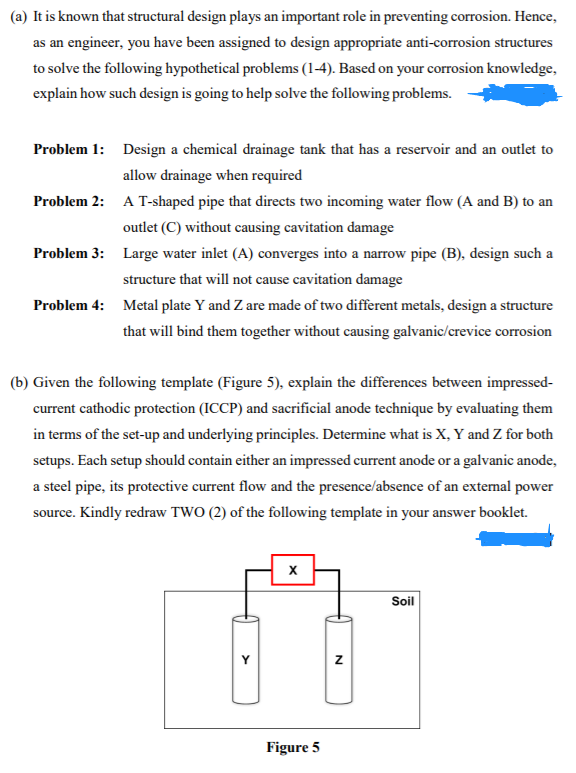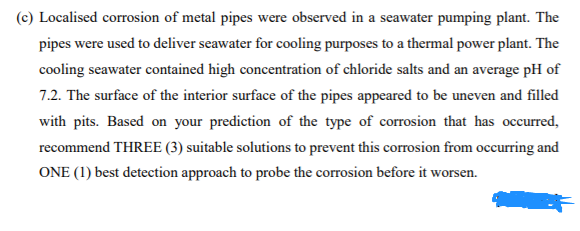Localised corrosion of metal pipes were observed in a seawater pumping plant. The pipes were used to deliver seawater for cooling purposes to a thermal power plant. The cooling seawater contained high concentration of chloride salts and an average pH of 7.2. The surface of the interior surface of the pipes appeared to be uneven and filled with pits. Based on your prediction of the type of corrosion that has occurred, recommend THREE (3) suitable solutions to prevent this corrosion from occurring and ONE (1) best detection approach to probe the corrosion before it worsen.
Localised corrosion of metal pipes were observed in a seawater pumping plant. The pipes were used to deliver seawater for cooling purposes to a thermal power plant. The cooling seawater contained high concentration of chloride salts and an average pH of 7.2. The surface of the interior surface of the pipes appeared to be uneven and filled with pits. Based on your prediction of the type of corrosion that has occurred, recommend THREE (3) suitable solutions to prevent this corrosion from occurring and ONE (1) best detection approach to probe the corrosion before it worsen.
Elements Of Electromagnetics
7th Edition
ISBN:9780190698614
Author:Sadiku, Matthew N. O.
Publisher:Sadiku, Matthew N. O.
ChapterMA: Math Assessment
Section: Chapter Questions
Problem 1.1MA
Related questions
Question
I want answers for part c please
subject is: Corrosion and Protection of Materials

Transcribed Image Text:(a) It is known that structural design plays an important role in preventing corrosion. Hence,
as an engineer, you have been assigned to design appropriate anti-corrosion structures
to solve the following hypothetical problems (1-4). Based on your corrosion knowledge,
explain how such design is going to help solve the following problems.
Problem 1: Design a chemical drainage tank that has a reservoir and an outlet to
allow drainage when required
Problem 2: A T-shaped pipe that directs two incoming water flow (A and B) to an
outlet (C) without causing cavitation damage
Problem 3: Large water inlet (A) converges into a narrow pipe (B), design such a
structure that will not cause cavitation damage
Problem 4: Metal plate Y and Z are made of two different metals, design a structure
that will bind them together without causing galvanic/crevice corrosion
(b) Given the following template (Figure 5), explain the differences between impressed-
current cathodic protection (ICCP) and sacrificial anode technique by evaluating them
in terms of the set-up and underlying principles. Determine what is X, Y and Z for both
setups. Each setup should contain either an impressed current anode or a galvanic anode,
a steel pipe, its protective current flow and the presence/absence of an extermal power
source. Kindly redraw TWO (2) of the following template in your answer booklet.
Soil
Figure 5

Transcribed Image Text:(c) Localised corrosion of metal pipes were observed in a seawater pumping plant. The
pipes were used to deliver seawater for cooling purposes to a thermal power plant. The
cooling seawater contained high concentration of chloride salts and an average pH of
7.2. The surface of the interior surface of the pipes appeared to be uneven and filled
with pits. Based on your prediction of the type of corrosion that has occurred,
recommend THREE (3) suitable solutions to prevent this corrosion from occurring and
ONE (1) best detection approach to probe the corrosion before it worsen.
Expert Solution
This question has been solved!
Explore an expertly crafted, step-by-step solution for a thorough understanding of key concepts.
Step by step
Solved in 3 steps

Knowledge Booster
Learn more about
Need a deep-dive on the concept behind this application? Look no further. Learn more about this topic, mechanical-engineering and related others by exploring similar questions and additional content below.Recommended textbooks for you

Elements Of Electromagnetics
Mechanical Engineering
ISBN:
9780190698614
Author:
Sadiku, Matthew N. O.
Publisher:
Oxford University Press

Mechanics of Materials (10th Edition)
Mechanical Engineering
ISBN:
9780134319650
Author:
Russell C. Hibbeler
Publisher:
PEARSON

Thermodynamics: An Engineering Approach
Mechanical Engineering
ISBN:
9781259822674
Author:
Yunus A. Cengel Dr., Michael A. Boles
Publisher:
McGraw-Hill Education

Elements Of Electromagnetics
Mechanical Engineering
ISBN:
9780190698614
Author:
Sadiku, Matthew N. O.
Publisher:
Oxford University Press

Mechanics of Materials (10th Edition)
Mechanical Engineering
ISBN:
9780134319650
Author:
Russell C. Hibbeler
Publisher:
PEARSON

Thermodynamics: An Engineering Approach
Mechanical Engineering
ISBN:
9781259822674
Author:
Yunus A. Cengel Dr., Michael A. Boles
Publisher:
McGraw-Hill Education

Control Systems Engineering
Mechanical Engineering
ISBN:
9781118170519
Author:
Norman S. Nise
Publisher:
WILEY

Mechanics of Materials (MindTap Course List)
Mechanical Engineering
ISBN:
9781337093347
Author:
Barry J. Goodno, James M. Gere
Publisher:
Cengage Learning

Engineering Mechanics: Statics
Mechanical Engineering
ISBN:
9781118807330
Author:
James L. Meriam, L. G. Kraige, J. N. Bolton
Publisher:
WILEY